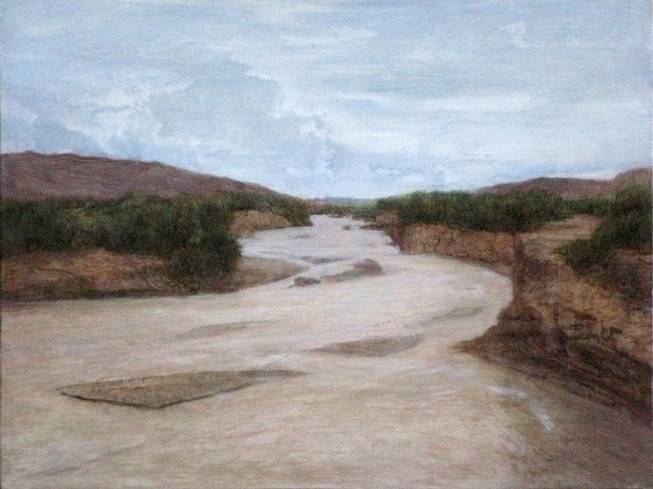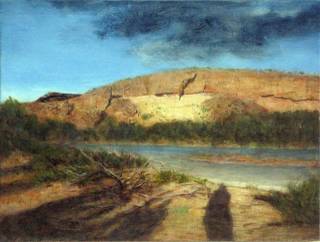
Courtesy/Robert Beckmann
This is one of five 15-inch by 20-inch oil paintings created by Robert Beckmann of various views of the Las Vegas Wash in the aftermath of a devastating flood on July 8, 1999. These new paintings are part of Robert Beckmann: Elemental Landscape, opening to the public at the Springs Preserve on Oct. 16.
Thursday, Oct. 8, 2009 | 6:46 p.m.
If you go
- What: "Robert Beckman: Elemental Landscape"
- When: 10 a.m. to 6 p.m., Oct. 16 to Jan. 7
- Where: Big Springs Gallery, Springs Preserve,
- Admission: Included with general admission to Springs Preserve and free to members.
When Robert Beckmann came to Nevada in the 1970s, he was wrapped as a rare creative species: an artist with a voracious intellectual appetite.
In 1977 Beckmann arrived in Las Vegas as a mural painter hired by the city. He brushed an abstract rainbow on the side of Dula Center, and it enchanted me, who, as a child, grew up in the glare of Las Vegas neon signs. The larger-than-life mural in Southern Nevada’s sunlight changed Vegas' views of art.
At that time, walking into his apartment east of the Las Vegas Strip became a trip to a library or a museum in an era when we had a short supply of both. His white walls lined with bookshelves contained philosophy, art history, science, Asian, African and Native American books and objects. Paintings in progress were strewn everywhere. Ask Beckmann a question about his art and Plato, Japanese artistic techniques and a touch of Buddhism came into the conversation. At the same time, he kept track of a mother coyote and her three pups living in a den behind his apartment, a stone’s throw from Strip resorts. Today, the area has been paved with concrete casinos and convention halls.
Born March 20, 1942, in Philadelphia, Beckmann grew up in Swathmore, a college town in Pennsylvania that nurtured his curiosity about the natural world. A budding naturalist, he soaked in knowledge about minerals and mushrooms. Then one day in Cape May, N.J., exquisite birdsong drew him into an encounter with a Yellow-Crowned Kinglet on a bird watch with the world-renowned Roger Tory Peterson (of Peterson’s Guide fame), who identified the Kinglet’s song. Beckmann, who was 8 at the time, and Peterson walked over to the song’s source, a small pine tree. Man and boy hunkered down. Peterson made a strange sound by kissing the back of his hand. The Kinglet appeared on the end of a limb, looking straight at Beckmann, three feet away. “I was thrilled and amazed at Peterson’s connection to the natural world. I’ve been listening and looking ever since,” Beckmann said.
When the Springs Preserve on Valley View Boulevard approached him to focus on water, waterfalls, rivers, lakes, the Las Vegas Wash, all things water, Beckmann began to develop a series of paintings illuminating places he has lived and worked spanning the past 30 years. “Robert Beckmann: Elemental Landscape” is the result. The exhibit features five new 15-inch by 20-inch oil paintings of the Las Vegas Wash in the aftermath of a devastating July 8, 1999, flash flood that prompted President Bill Clinton to declare the Las Vegas Valley a disaster area with $20 million in damages to public property.
From the roaring brown floodwaters that moved boulders the size of a living room, Beckmann brings us, the tempest-tossed, to the Las Vegas Wash the day after the flood, revealing a beauty that most urban desert dwellers never imagine. Through Beckmann’s tender eyes, natural Las Vegas emerges. Calling Oregon his home today, Beckmann draws on the breath-taking waterfalls in the Pacific Northwest, leaping between the arid and the iridescent in all water’s forms.
“Mr. Beckmann brings the emotion and majesty of nature to life in literal and abstract representations,” said Elizabeth Herridge, managing director of the Springs Preserve, formerly of the Guggenheim. “The thematic explorations of ‘Elemental Landscape’ is an idea fit for the Preserve and a great way to kick off the fine art programming planned for 2010 and beyond in the Preserve’s galleries.”
Beckmann’s exhibit is the first in this series of fine art tied to the Springs Preserve mission, that of educating people about the scarce and precious resource taken for granted so often: water.
Bob Beckmann’s work has always delivered an organic, visceral, often wrenching view of the world both in nature and in humanity. A slot machine with an atomic bomb’s mushroom cloud, a house from Mr. Roger’s neighborhood blown away in panel after panel – like a freeze-framed film clip – in an atomic bomb’s shock wave, to the Las Vegas Strip as backdrop for a wry look at the Old Masters in his “Vegas Vanitas” series are just some of the paintings I’ve watched him produce over the decades. Beckmann’s murals stand more than 200 strong, large and small, in Southern Nevada. His paintings help us experience the Cold War up close, as viewers gasp at the potent and powerful “Body of a House” panels, a smaller canvas revealing a schoolyard with children playing under sunny skies hints at a mushroom cloud in the background. “That was so painful for me to paint,” Beckmann told me when it appeared in Henderson’s Water Street Gallery. The painting encapsulates the innocence of children going about their play with the menacing nuclear arms race looming.
The “Vegas Vanitas” paintings put romantic art from a bygone era into modern dress. For example, “The Hundred Year Flood” depicts the Luxor and it laser-like light beam as backdrop to Nicholas Poussin’s “Winter” painted in 1660. Except the Beckmann version stands in the Las Vegas Wash.
Nature came naturally to Beckmann’s body of work. In 2005 he completed six murals for the U.S. Botanic Garden in Washington, D.C., representing plants most important to the world’s economy: rice, tea, citrus fruits, cotton, cocoa, corn and details from each country where they are farmed. Beckmann employed 21st century chemistry from New York and Germany to remain true to those native subjects. Each 500-pound panel measuring 7 feet by 12 feet will last 200 years showing cotton from Egypt, cocoa from Brazil, corn from Iowa, citrus from Spain, rice from Bali and tea from Japan.
In “Elemental Landscape” prepare to experience our Mojave Desert home and the Pacific Northwest’s abundant waters through the vision of a modern artist who steeps himself in the worlds of nature and art, much as the great Leonardo da Vinci did.
“Robert Beckmann: Elemental Landscape” will be on exhibit from Oct 16 to Jan. 7, 2010, in the Big Springs Gallery located inside the Origen (derived from two words: Original and Generator) Experience at the Springs Preserve.


Join the Discussion:
Check this out for a full explanation of our conversion to the LiveFyre commenting system and instructions on how to sign up for an account.
Full comments policy